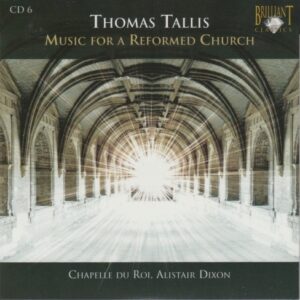 Today’s CD is another fascinating, but aurally tiring delight.
Today’s CD is another fascinating, but aurally tiring delight.
Titled, “Music For a Reformed Church,” CD 6 of the Thomas Tallis box set by Brilliant Classics is another slice of history that I believe everyone should hear at least once in their lives.
Once again, the liner notes (this time written by John Morehen in February of 2003) provide essential background to what I’m hearing.
I will provide a brief excerpt here:
Music for a Reformed Church
This sixth CD of Chapelle du Roi’s recording of the Complete Works is devoted to music which Thomas Tallis (d.1585) composed for use during the reformed services promulgated in The booke of the common prayer, which came into effect on Whitsunday (9 June) 1549 following the passage of An Act for the Uniformity of service by both Houses of Parliament earlier that year. This statutory introduction of services in the vernacular brought to an end the fifteen-year period of liturgical and musical experimentation which followed Henry VIII’s formal break with Rome in 1534.
Tallis’s music, together with the associated intonations and collects (for Easter Day at Matins and for the Fourth Sunday in Advent at Evensong), is here presented in the normal liturgical sequence for the day—Matins, Holy Communion, and Evensong. It concludes with Tallis’s nine psalm-tune harmonisations which he contributed to Archbishop Matthew Parker’s Psalter, published in about 1567.
Little of the music on this recording can be reliably dated. Very few printed or manuscript music sources have survived from the period of Tallis’s lifetime…
For the rest, you’ll have to buy the box set.
Just the Facts
CD 6 of this 10-CD box set consists of 33 tracks that clock in at 77:53. (That’s nearly one hour and 20 minutes!) Many, many years ago, I read that 80 minutes is the maximum amount of data that can be placed on a standard CD.
placed on a standard CD.
So this disc noses up against that limit with 33 tracks of some of the most beautiful liturgical music ever written and recorded.
As with the previous CDs, the music on this one was performed by Chapelle du Roi, conducted by Alistair Dixon.
It was recorded on July 24-26, 2000, at St. Jude’s Hampstead.
It is marked DDD, which means it is an all-digital recording. (Digitally recorded, Digitally mixed, and Digitally mastered.) Purists, those folks who think vinyl sounds better than CDs (they’re wrong) would probably look askance at this recording. But, to my ears, this is the best way to record music to precisely capture every note. But what do I know?
Just the Feelings
Recording quality: 5
Overall musicianship/vocals: 5
CD liner notes: 5
How does this make me feel: 4
Although is titled “Music For a Reformed Church,” this sounds almost exactly like what I used to hear when I visited The Abbey of Our Lady of Gethsemani in rural Kentucky. The monks at Gethsemane chanted just like this (minus the female vocals, of course). So, it sounds less like music for a Reformed Church and more like music for a Catholic monastery.
But that doesn’t make it bad. It just makes it familiar to me.
This is especially evident in Tracks 6 and 7. The call-and-response (antiphonal, I believe it’s called) construction of these songs is very reminiscent of what one would hear at one of the Liturgy of the Hours at Gethsemani.
For example, this is what I’m hearing in Track 7 – “Commandments”
1. God spake these words, and said; I am the Lord thy God: thou shalt have none other gods before me.
R. Lord, have mercy upon us and incline our hearts to keep this law.
2. Thou shalt not make to thyself any graven image, nor the likeness of any thing that is in heaven above, or in the earth beneath, or in the water under the earth. Thou shalt not bow down to them, nor worship them: for I the Lord thy God am a jealous God, and visit the sins of the fathers upon the children unto the third and fourth generation of them that hate me, and shew mercy unto thousands of them that love me and keep my commandments.
R. Lord, have mercy upon us and incline our hearts to keep this law.
The enumerated part is chanted by one singer. (Think of Rex Harrison talk-singing in My Fair Lady.) The whole choir comes in at the “R” (for Response) part.
And so it goes.
This is great music, partly because it’s sung in English and partly because it’s familiar, yet different.
It’s very well recorded and performed. Two thumbs up!
